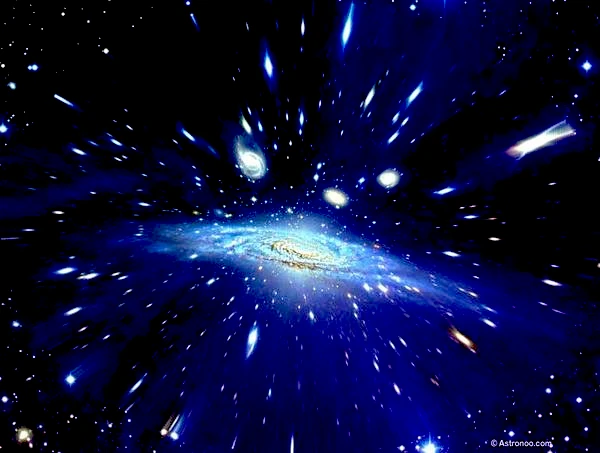
Image description: If an observer travels at a very high speed, close to the speed of light, they will have the illusion of seeing all the objects in the Universe in front of them, both those in front and those behind. All objects will tend to cluster in the direction the observer is moving. This is the phenomenon of aberration of light. Additionally, due to the Doppler effect, the wavelengths of light sources will compress, and the panorama will slightly turn blue. Finally, the amount of light will vary considerably, becoming stronger in front and weaker behind. Image source: astronoo.com
We have all observed the rain falling on our windshield when we are moving quickly in a car. This strange optical phenomenon makes us believe that the rain is falling diagonally towards us when it is actually falling vertically. The faster we move, the more the rain falls "slanted." In other words, the apparent direction of the raindrops depends on the speed. For those who sail, the same phenomenon is observable but this time with the wind. The faster the sailboat goes, the more the sailors feel like they are heading into the wind.
In summary, when we are stationary, the rain falls vertically, and the source of the raindrops is above our heads. The faster we move, the more the source of the raindrops appears in the direction of our movement, that is, in front of us. This optical phenomenon that we observe with rain also happens with wind; the faster our sailboat goes, the more the apparent direction of the wind seems to be in the direction of our movement.
This optical phenomenon also applies to light. It was James Bradley (1693-1762) who is said to have had the idea of applying this phenomenon to light after a sailing trip on the Thames with a sailor who explained the phenomenon to him. In 1725, by studying the variations in the apparent position of the star γ Draconis, Bradley understood the phenomenon.
This non-intuitive relativistic phenomenon is called the Aberration of Light. Aberration is therefore the change in the apparent direction of a signal when moving. The faster we go, the more the scenery seems to cluster towards the front in the direction of movement. Conversely, the rear of the scenery expands.
If an observer travels at the speed of light, they will have the surprising illusion of seeing in front of them all the objects located in front but also all the objects located behind.
Another effect occurs when we move quickly, which is the Doppler effect. This effect is well known because we have all heard the sound of an ambulance approaching and then moving away. When the ambulance approaches us, the sound of the siren is higher-pitched; when it moves away, the sound of the siren is lower-pitched.
This phenomenon also applies to light waves. While for sound it is the pitch that varies, for light it is the color. When approaching a light source, the wavelength compresses, and the light source will slightly turn blue. When moving away, the wavelength of the light source stretches towards red, and it will slightly turn red.
Another effect adds to the previous ones when we move quickly. With the speed of movement, the light flux will increase in the same way that the flow of a river increases when moving quickly on the water.
The apparent flow of the river seems more significant than when stationary. When moving at a speed close to the speed of light, the amount of light varies considerably, becoming stronger in front and weaker behind. To the point of seeing completely saturated light in front and complete darkness behind.
N.B.:
Between the wavelength (λ) and the frequency (ν) exists the following relationship: ν = c / λ where ν = wave frequency in hertz, c = speed of light in vacuum in m/s, and λ = wavelength in meters.